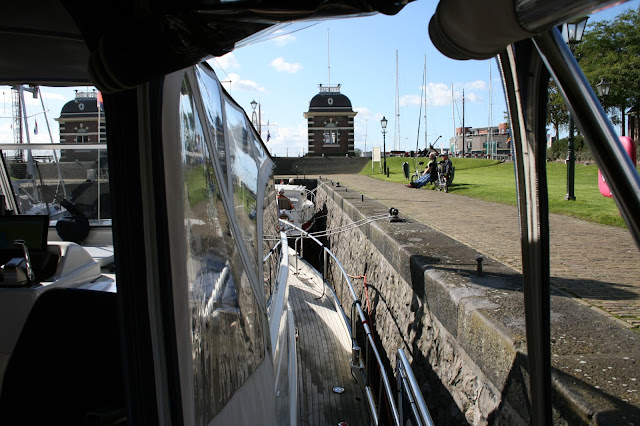One of my first planned projects on Pirramimma was to change the impeller covers from the existing ones fitted by the engine manufacturers to new SpeedSeal covers. It only took me about ten months to get around to it, and of course the impeller on the genny destroyed itself before I had done the work, as noted in my earlier blog.
The idea of the SpeedSeal is threefold. Firstly to increase the lifespan of the impeller by reducing friction, secondly to reduce the likelihood of the impeller disintegrating in the event of loss of cooling water from, for example, a blocked water filter, and thirdly, to enable a quick change of impeller when it is necessary.
When you open the package, this is what you get:
 |
| Silicone lubricant, 4 s/s hand screws, O ring, cover, PTFE bearing, impeller removal tool |
This is the generator housing in the engine room and I must say that it is a complete luxury to be able to work on a marine engine when access is as easy as this …
 |
| generator box |
 |
| … with part of the cover removed |
First thing is to shut off the raw water seacock:
 |
| closing the seacock |
The generator is a Fischer Panda with a Kubota engine and the pump - this one is a Johnson - couldn't be easier to get to:
 |
| The Johnson pump as supplied - nearly |
… which is not to say that it is impossible to drop one of the screws. In the picture above you can see 5 original screws plus one hand screw. (The sixth screw is somewhere under the engine which, as we all know, is where they think they belong). I dropped the screw when I was replacing the impeller earlier in the summer.
Undo the screws and remove the plate. This will expose the impeller which you remove by whatever is your favourite method. The little red plastic 'impeller remover' that came with the SpeedSeal kit didn't really work for me. There is probably a knack, which I didn't have. I will have another attempt next time I have to do this job.
 |
| Damaged impeller |
The object of this exercise was merely to replace the cover, but when I exposed the impeller, this sight was a bit of a shock; you can see that all six vanes are split. The impeller had been in for 63 days with only 22.5 hours of use. After discussing the issue with my friend Diederick, he thought that it may have failed from too much water pressure caused by a partially blocked heat exchanger, and/or the pipes leading to it. I borrowed an industrial strength wet & dry vacuum, modified the business end with a short length of hosepipe, and managed to extract several bits of debris:
 |
| bits of old impeller removed from the cooling system |
Once the old impeller is out, the inside of the impeller housing is exposed. This you coat liberally with some of the lubricant supplied with the kit.
 |
| The empty housing showing the shaft that drives the impeller. |
Smear the same lubricant over the new impeller and insert, making sure that the vanes are compressed the correct way. On this pump, the water flows from top to bottom so the impeller rotates clockwise.
 |
| The new impeller in place. |
When you see the impeller in its housing like this, you realise how much of a thrashing they get during their working life.
Taking the new SpeedSeal cover, you again coat all the inside bits with the lubricant, insert the O ring into its groove, place the PTFE bearing in the middle, cover it with the metal plate and offer up the whole thing to the pump housing. The lubricant holds everything in place, so this job is blissfully simple - nothing drops out. Slide the new cover over the two hand screws which you have partially screwed into the housing:
 |
| New cover |
 |
| The clever bit |
The inspired bit of thinking about the SpeedSeal is the fact that the two lower screw holes are actually slots which means that the cover is slid on and off the housing; only the top two hand screws need to be removed. This makes replacing an impeller a two minute - or less - job. Unless, ahem, you need to find bits of the old impeller.
Insert the top two screws after adding a dab of lubricant to them, and tighten by hand, going round three or four times to take up any slack as the unit beds down.
 |
| Tightening the hand screws |
Finally, open the seacock, start the engine and check for leaks.
 |
| Final job is to open the seacock. |
 |
| It works. |
The blessed sight of gallons of water sluicing through the filter!
Here is one last picture of the second new SpeedSeal fitted to the main engine, which is a Perkins.
/Rich.



































